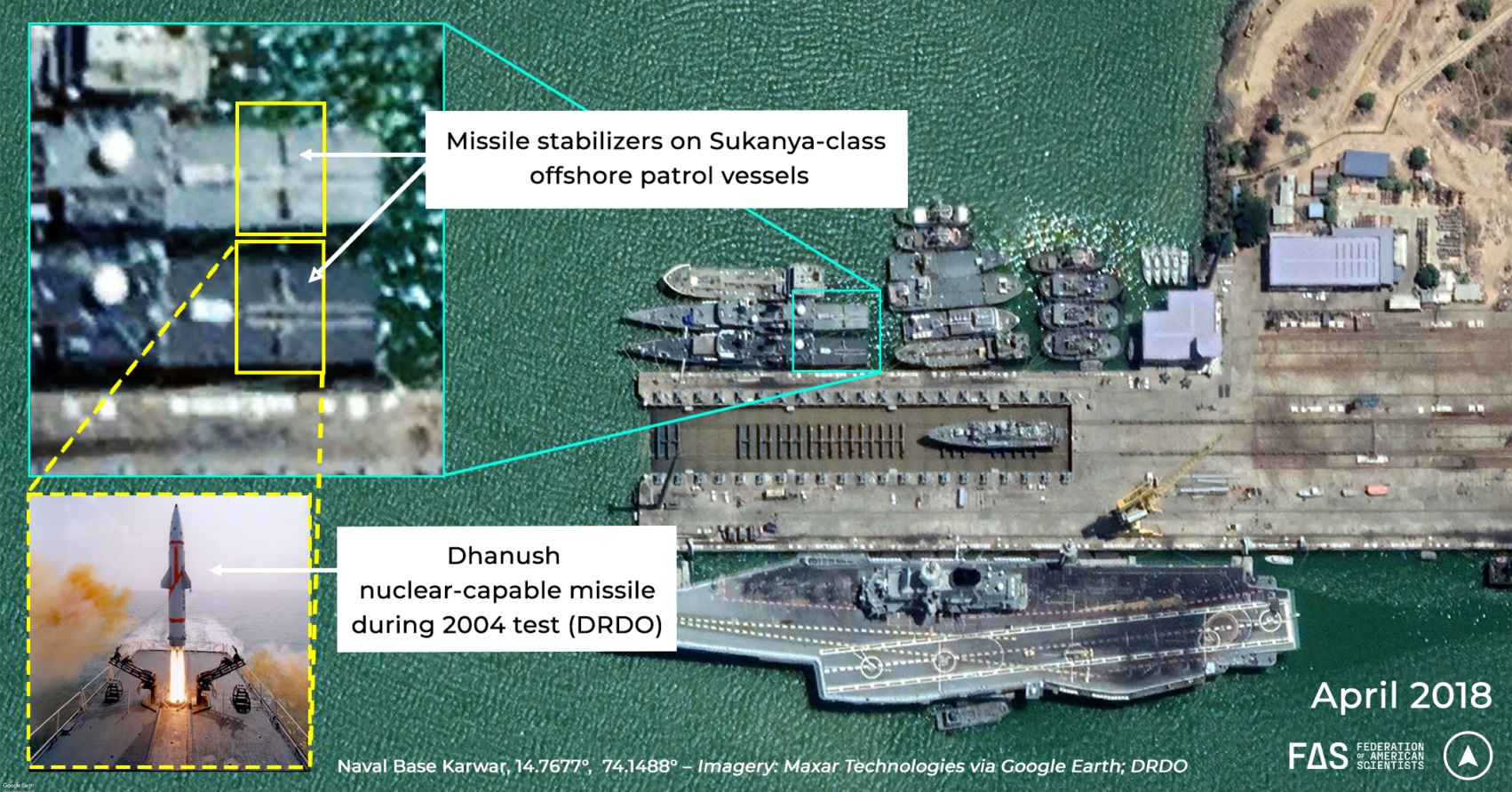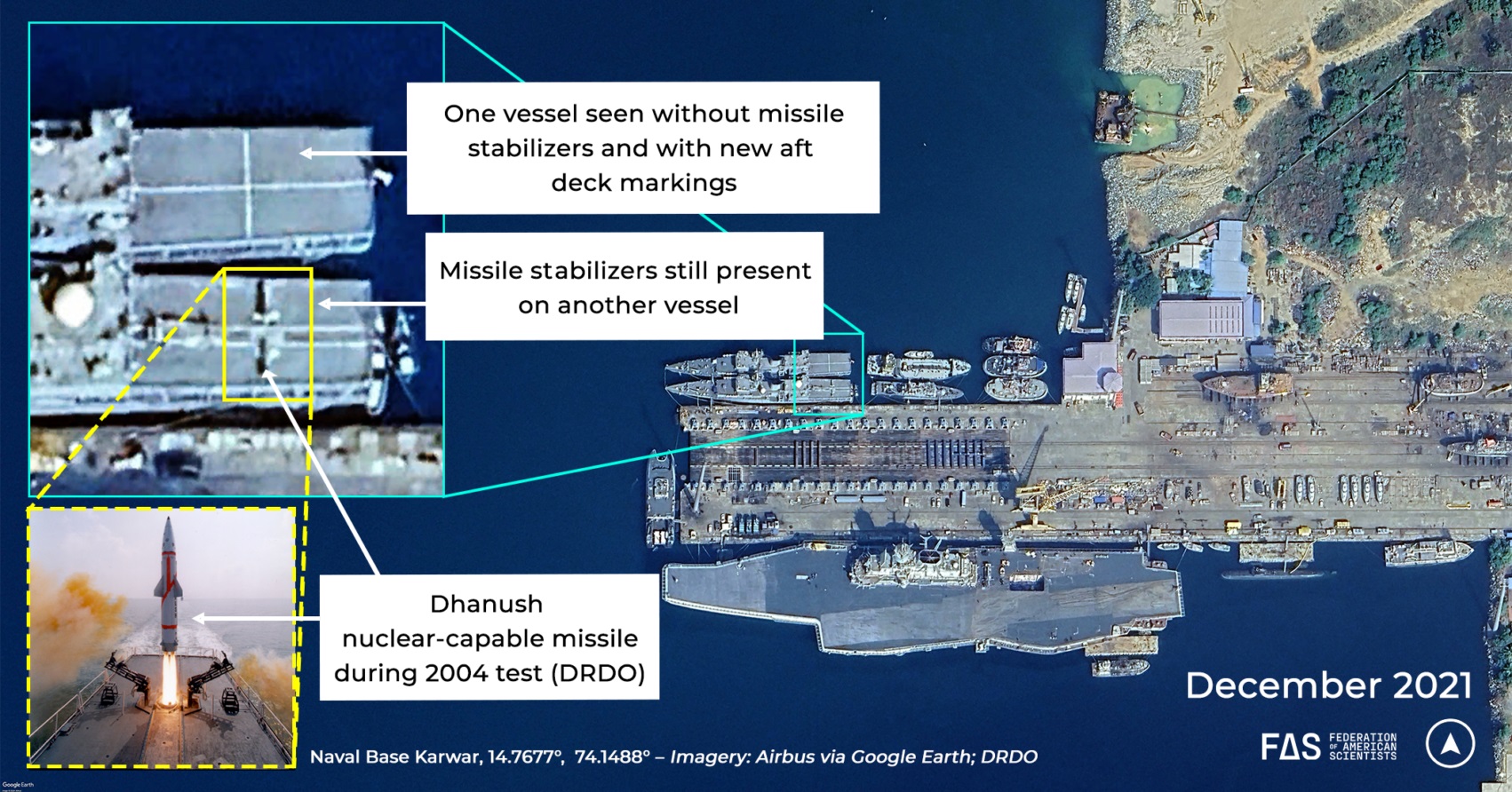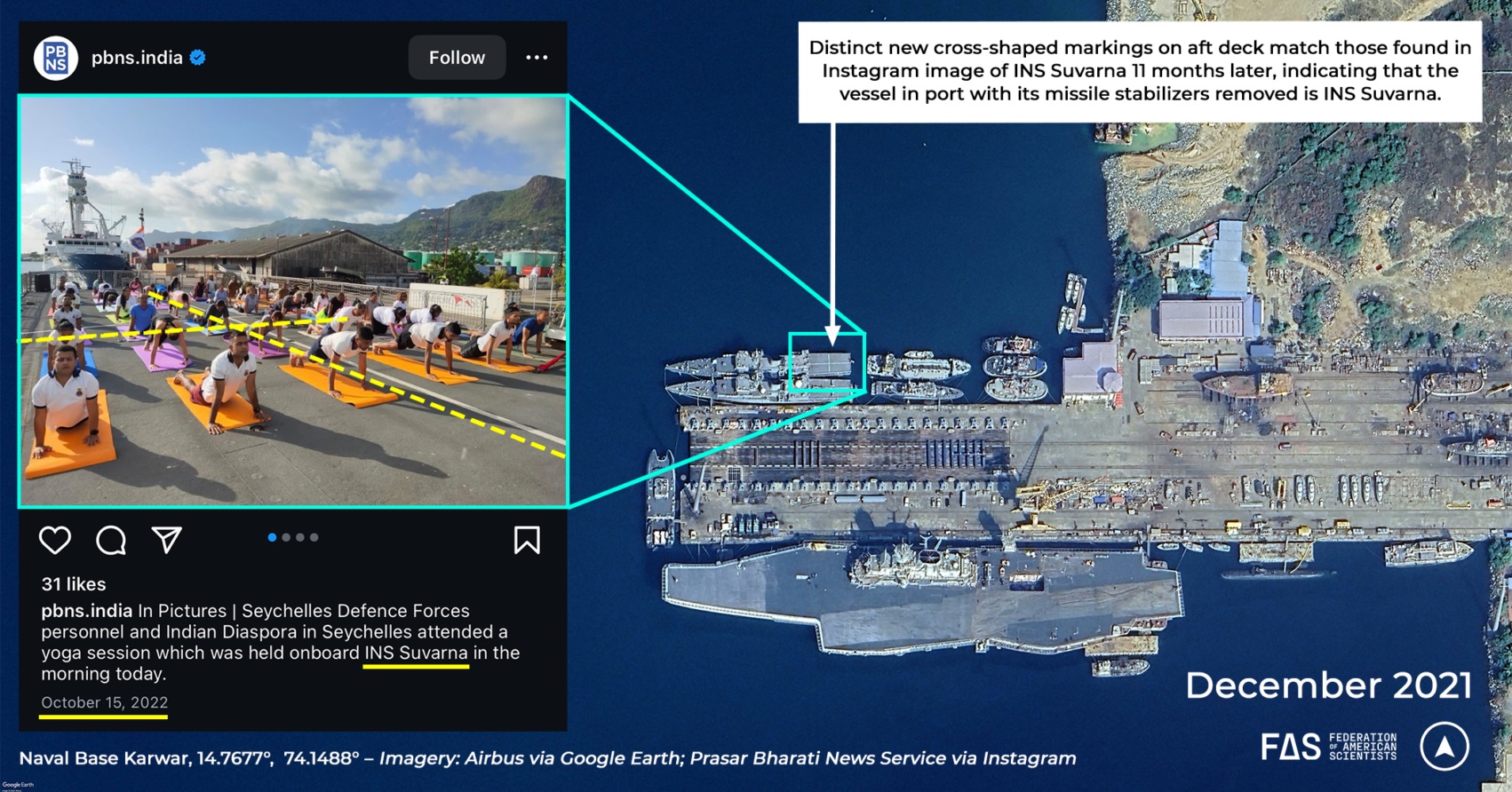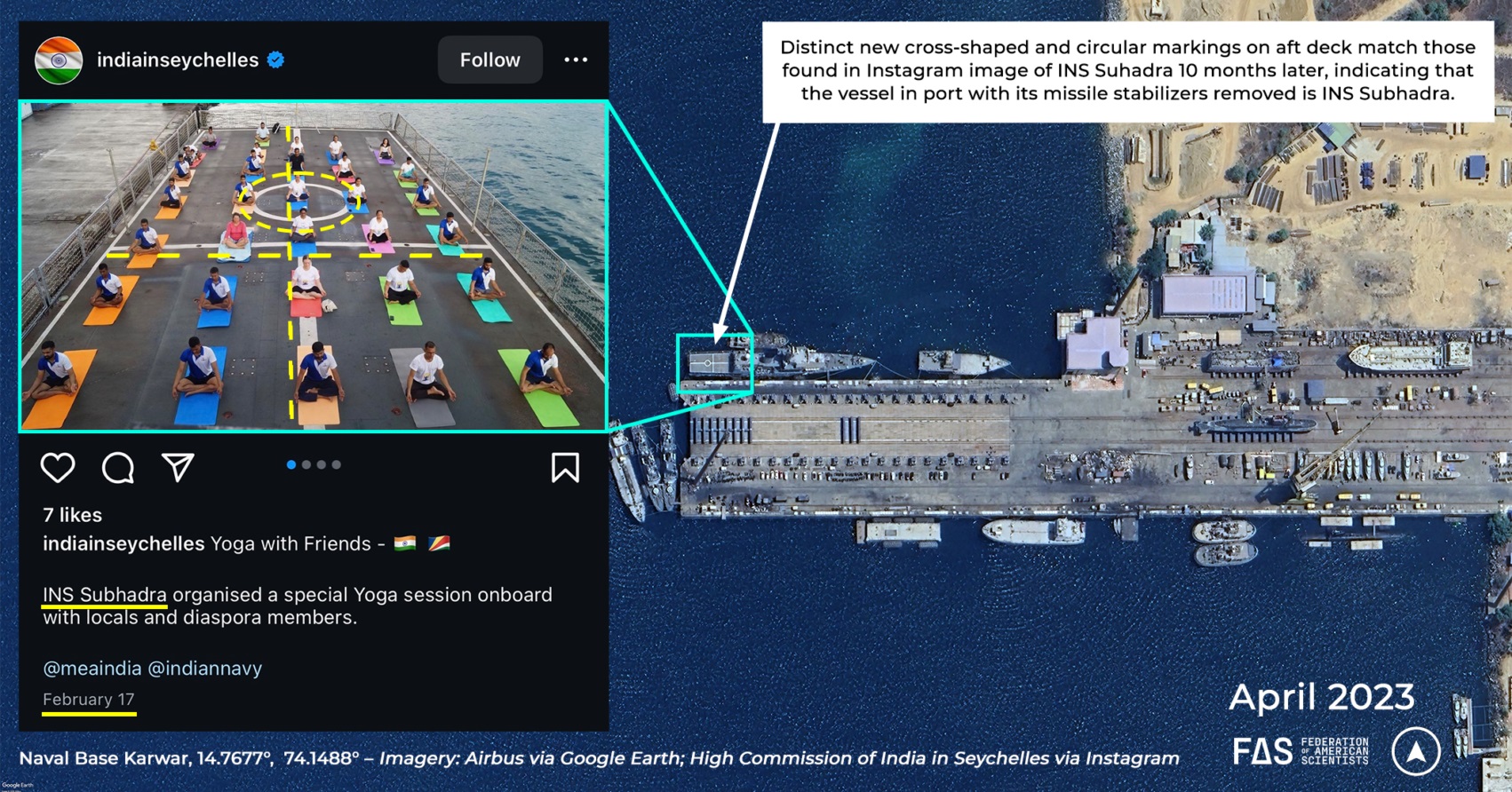| Hot-Launch Yoga: Cobra Pose Reveals Nuke Repose
热启动瑜伽:眼镜蛇的姿势揭示了核武器的休息 Date:2024-08-14 Source:fas.org By: MATT KORDA Viewed: |
08.13.24
TEXT BY MATT KORDA
马特·科尔达的文字
The Indian Navy has integrated yoga into its training practices for decades, and in recent years it has conducted yoga sessions onboard its warships during port visits as a form of cultural diplomacy. These events, and the social media posts documenting them, occasionally offer fascinating data points about the status of specific military capabilities.
几十年来,印度海军一直将瑜伽融入其训练实践中,近年来,作为一种文化外交形式,印度海军在港口访问期间在军舰上进行瑜伽课程。这些事件以及记录这些事件的社交媒体帖子偶尔会提供有关特定军事能力状况的有趣数据点。
In particular, yoga-related social media posts and satellite imagery now indicate that one of India’s oldest naval missiles capable of launching nuclear weapons has likely been retired as the country continues to develop its sea-based nuclear deterrent.
特别是,与瑜伽相关的社交媒体帖子和卫星图像现在表明,随着印度继续发展其海基核威慑力量,印度最古老的能够发射核武器的海军导弹之一可能已经退役。
For nearly 15 years, India’s naval nuclear forces solely consisted of two offshore patrol vessels that had been specially configured to launch nuclear-capable Dhanush missiles.
近15年来,印度海军核力量仅由两艘海上巡逻舰组成,这些巡逻舰经过特殊配置,可以发射具有核能力的“达努什”(Dhanush)导弹。
The Dhanush––a variant of India’s Prithvi short-range ballistic missile––had always been somewhat of an odd capability for India’s navy. Given its relatively short range and liquid-fuel design––meaning that it would need to be fueled immediately prior to launch––the Dhanush’s utility as a strategic deterrence weapon was severely limited. The ships carrying these missiles would have to sail dangerously close to the Pakistani or Chinese coasts to target facilities in those countries, making them highly vulnerable to counterattack.
“达努什”——印度“大地”(Prithvi)短程弹道导弹的改型——对印度海军来说一直是一种奇怪的能力。鉴于其相对较短的射程和液体燃料设计——这意味着它需要在发射前立即加燃料——“达努什”作为战略威慑武器的效用受到严重限制。携带这些导弹的船只将不得不危险地靠近巴基斯坦或中国海岸,以瞄准这些国家的设施,使其极易受到反击。
For those reasons, we have continuously assessed that as India’s long-planned nuclear-powered ballistic missile submarines become operational, the Dhanush would eventually be phased out.
出于这些原因,我们一直在评估,随着印度长期计划的核动力弹道导弹潜艇投入使用,“达努什”最终将被淘汰。
New data points from social media and satellite imagery indicate it is very likely that this has now happened.
社交媒体和卫星图像的新数据点表明,这很可能已经发生。
––
For years, India’s nuclear-capable Dhanush missiles were carried by two specially configured Sukanya-class offshore patrol vessels, known as INS Subhadra (hull number P51) and INS Suvarna (P52). These two vessels have been most clearly distinguishable from India’s four other Sukanya-class patrol vessels by the presence of missile stabilizer platforms on their aft decks that could be clearly seen through satellite imagery, including in this image from April 2018.
多年来,印度具有核能力的“达努什”导弹由两艘特殊配置的苏坎亚级海上巡逻舰携带,称为苏巴德拉号(舷号P51)和I苏瓦尔纳号(P52)。这两艘舰艇与印度其他四艘苏坎亚级巡逻舰最明显的区别在于,它们的后甲板上有导弹稳定器平台,可以通过卫星图像清楚地看到,包括2018年4月的这张图像。
The last time that any official Indian source had indicated that the Dhanush capability was still operational was in 2019, when two Facebook posts by the Indian Navy’s official page specifically mentioned the capability and implied that it was still active on both INS Subhadra and INS Suvarna.
印度官方消息人士上一次表示“达努什”能力仍在运行是在2019年,当时印度海军官方页面的两个Facebook帖子特别提到了这种能力,并暗示它在苏巴德拉号和苏瓦尔纳号上仍然发挥作用。
In December 2021, satellite imagery from Airbus showed two Sukanya-class vessels at Naval Base Karwar, one with missile stabilizers and the other without. The vessel without stabilizers also featured new aft deck markings in a cross pattern that had not been seen before on other vessels of that class. Without additional images, it was unclear whether the vessel featuring the new markings was one of the two nuclear-capable ships or another ship in the Sukanya-class that is also home-ported at Karwar––INS Sukanya (P50). If the vessel without stabilizers was the INS Sukanya, then the markings on the ship would not have necessarily indicated any change to the nuclear mission, since INS Sukanya had never been equipped with missile stabilizers. If the new pattern belonged to one of the two vessels that had previously been equipped with those stabilizers, however, then it would indicate that those stabilizers had been removed, thus likely eliminating that vessel’s nuclear strike role and removing the Dhanush missile from combat duty.
2021年12月,空中客车公司的卫星图像显示,卡瓦尔海军基地有两艘苏坎亚级舰艇,一艘装有导弹稳定器,另一艘没有。这艘没有稳定器的船只还采用了新的后甲板标记,其交叉图案在该级别的其他船只上从未见过。在没有其他图像的情况下,尚不清楚这艘带有新标记的船只是两艘具有核能力的船只之一,还是另一艘同样以卡尔瓦尔为母港的苏坎亚级船只——INS苏坎亚号(P50)。如果没有稳定器的船只是“苏坎亚”号,那么船上的标记不一定表明核任务有任何变化,因为“苏坎亚”号从未配备过导弹稳定器。然而,如果新模式属于之前配备了这些稳定器的两艘舰艇中的一艘,那么这将表明这些稳定器已被拆除,从而可能消除该舰艇的核打击作用,并将“达努什”导弹从战斗任务中移除。
Clarity arrived through a strange medium: a series of yoga-related Instagram posts published by India’s public broadcaster during port visits to Seychelles in October 2022, indicating that the vessel with the new deck markings was indeed INS Suvarna. This meant that as of December 2021 at the latest, the missile stabilizers on INS Suvarna had been removed, meaning that the vessel has since been unable to launch nuclear-capable Dhanush ballistic missiles.
澄清是通过一种奇怪的媒介实现的:2022年10月,印度公共广播公司在访问塞舌尔港口期间发布了一系列与瑜伽相关的Instagram帖子,表明带有新甲板标记的船只确实是苏瓦尔纳号。这意味着,最迟在2021年12月,苏瓦尔纳号上的导弹稳定器已被拆除,这意味着该舰艇此后无法发射具有核能力的“达努什”弹道导弹。
At the exact same time that the crew of INS Suvarna was practicing yoga in Seychelles, another satellite image captured by Maxar Technologies showed another Sukanya-class patrol vessel at Naval Base Karwar with its aft deck under construction. Similarly to the previous case, it remained unclear whether this vessel was the nuclear-capable INS Subhadra or the non-nuclear INS Sukanya. A subsequent satellite image in April 2023 indicated that the aft deck had been repainted with a new cross pattern with a circle––likely to be used as a helipad.
就在苏瓦尔纳号(INS Suvarna)的船员在塞舌尔练习瑜伽的同时,美国麦克萨公司(Maxar Technologies)拍摄的另一张卫星图像显示,另一艘苏坎亚级巡逻舰在卡瓦尔海军基地,其后甲板正在建造中。与之前的情况类似,目前尚不清楚这艘船是具有核能力的苏巴德拉号(INS Subhadra)还是非核苏坎亚号。2023年4月的一张后续卫星图像显示,后甲板已重新喷涂了一个新的圆形十字图案,可能用作直升机停机坪。
This same unique deck pattern was then on full display at another yoga session in Seychelles, during a port visit by INS Subhadra in February 2024. This indicates that this vessel lost its ability to deliver nuclear-capable Dhanush missiles when its aft deck began construction around October 2022.
2024年2月,在苏巴德拉号访问塞舌尔港口期间,这种独特的甲板模式在塞舌尔的另一场瑜伽课上得到了充分展示。这表明,当其后甲板于2022年10月左右开始建造时,该舰艇失去了发射具有核能力的“达努什”导弹的能力。
Since then, neither vessel has been seen with its missile stabilizer platforms returned to the aft deck, suggesting that the nuclear-capable Dhanush has finally been removed from active service and that the nuclear strike mission for the Sukanya-class patrol vessels has likely been retired. Given that the Dhanush is a close variant of India’s land-based Prithvi SRBM, it is likely that the Dhanush’s associated warheads have not been dismantled, but instead have been returned to India’s stockpile for use by these short-range systems.
自那以后,两艘舰艇都没有看到导弹稳定器平台返装甲板,这表明具有核能力的达努什号终于退役,苏坎亚级巡逻舰的核打击任务可能已经退役。鉴于“达努什”是印度陆基“大地”近程弹道导弹的改型,达努什的相关弹头很可能没有被拆除,而是被归还给印度的库存,供这些短程系统使用。
—
Although the yoga-related source of the news may have been surprising, the Dhanush missile’s retirement in itself was not. For years, we have assumed that the system would be eliminated once India’s sea-based deterrent reached a higher level of maturity. That time appears to be now: after years of delays, India’s second ballistic missile submarine––INS Arighat––is expected to be commissioned into the Navy before the end of 2024. Two more ballistic missile submarines are expected to follow over the course of this decade, and satellite imagery indicates that they will be able to carry double the number of missiles as India’s first two submarines.
尽管与瑜伽相关的消息来源可能令人惊讶,但“达努什”导弹的退役本身并不令人惊讶。多年来,我们一直认为,一旦印度的海基威慑达到更高的成熟度,该系统就会被淘汰。现在看来是时候了:经过多年的拖延,印度的第二艘弹道导弹潜艇“觅敌者”号(ins arighat)预计将在2024年底前服役于海军。预计在这十年中,还将有两艘弹道导弹潜艇紧随其后,卫星图像显示,它们将能够携带的导弹数量是印度前两艘潜艇的两倍。
More details on these developments, as well as other elements of India’s evolving nuclear arsenal, will be available in our forthcoming September publication: Indian Nuclear Weapons, 2024, in the Bulletin of the Atomic Scientists.
有关这些发展的更多细节,以及印度不断发展的核武库的其他要素,将在我们即将于9月出版的《原子科学家公报》上发表:《2024年印度核武器》。
This research was carried out with generous contributions from the Carnegie Corporation of New York, the Jubitz Foundation, the New-Land Foundation, Ploughshares Fund, the Prospect Hill Foundation, Longview Philanthropy, and individual donors.
这项研究是在纽约卡内基公司、朱比茨基金会、新土地基金会、犁头基金会、展望山基金会、朗维尤慈善基金会和个人捐助者的慷慨捐助下进行的。
上一篇:Integrated masts:the sensor sweet spot 下一篇:What’s next for Ukraine’s incursion into Russia?
| The Booker dilemma: inside US Army transformation
“布克”困境:美国陆军转型内幕 |
| The decision to cancel the M10 Booker light tank is at the core of a reordering of US Army planning.... [2025-07-16] |
| Focus: A fragile balance in Asia, China has become leading military power in the
焦点:亚洲平衡脆弱,中国已成为该地区的主要军事力量 |
| However, China's rapid military growth in this area is tipping the balance in favor of regional power. ... [2024-08-27] |
| Small drones will soon lose combat advantage, French Army chief says
法国陆军总司令表示,小型无人机将很快失去战斗优势 |
| By Rudy Ruitenberg Thursday, Jun 20, 2024 作者:鲁迪瑞滕伯格 2024年6月20日星期四 French Army Chief of Staff Gen. Pierre Schill inspecting a Rapid Eagle anti-drone system at the Eurosatory defense show in Paris on June 19, 202... [2024-08-18] |
| What’s next for Ukraine’s incursion into Russia?
乌克兰入侵俄罗斯的下一步是什么? |
| Ukraine’s forces have surprised us all with its recent incursion into Russia’s Kursk Oblast since the operation to turn the tide of the war,... [2024-08-17] |






